
Introduction
You follow a dedicated hair care routine, invest in high-quality products, and still find yourself battling dryness, frizz, and breakage. It’s a frustrating cycle. What if the problem isn’t the products you’re using, but the small, seemingly harmless habits you perform every day? Many of us are making common hair mistakes without even realizing it, unintentionally causing the very hair damage we’re trying to prevent.
Understanding these hidden culprits is the key to unlocking the healthy, vibrant hair you’ve been working towards. A healthy hair routine goes beyond just shampoo and conditioner; it involves how you wash, dry, style, and even sleep. By the time you finish this guide, you will be able to identify the 15 most common hair care mistakes that secretly damage your hair and learn exactly how to fix them for good.
Understanding Hair Damage: What’s Happening to Your Strands?
To fix hair damage, it helps to know what you’re up against. On a microscopic level, a healthy hair strand is protected by a smooth, overlapping layer of scales called the cuticle. When hair is damaged, these cuticles lift, chip, and break away. This erosion leaves the inner core of the hair exposed, making it difficult for your hair to retain moisture and maintain its internal protein structure.
The result is a collection of familiar hair woes: dryness, brittleness, split ends, and a dull, frizzy appearance. The cause of this hair cuticle damage can range from chemical treatments to environmental factors, but it’s most often the result of daily hair care mistakes.
Different hair types also react to damage uniquely. For instance:
- Fine hair is more fragile and can be easily weighed down by heavy products or broken by aggressive styling.
- Coarse hair has a thicker structure but can be prone to dryness and requires more moisture to stay healthy.
- Hair porosity—your hair’s ability to absorb and retain moisture—plays a huge role. Low porosity hair resists moisture, leading to product buildup, while high porosity hair absorbs it quickly but loses it just as fast, causing frizz and dryness.
Recognizing these factors is the first step in creating a personalized and effective hair care plan.
15 Common Hair Care Mistakes to Avoid
Are you guilty of any of these hair damage causes? Let’s dive into the habits you need to break and the simple solutions that will transform your hair health.
1. Over washing Your Hair
Washing your hair too often is one of the most widespread hair care mistakes. Your scalp produces natural oils (sebum) that travel down the hair shaft, providing essential moisture and protection. Frequent washing, especially with harsh shampoos, strips these oils away. In response, your scalp might overcompensate by producing even more oil, leading to a vicious cycle of greasy roots and dry ends. This is a classic cause of over-washing hair damage.

The Fix:
- Reduce Frequency: Train your hair by gradually extending the time between washes. For an oily scalp, aim for every 2-3 days. For dry or curly hair, once a week might be sufficient.
- Use Gentle Products: Opt for a sulfate-free shampoo that cleanses without stripping natural moisture.
- Embrace Dry Shampoo: On in-between days, use a quality dry shampoo to absorb excess oil at the roots and add volume.
2. Using the Wrong Shampoo and Conditioner
Using a shampoo and conditioner that isn’t formulated for your hair type is like trying to fit a square peg in a round hole. A product designed for fine, oily hair will be too drying for thick, curly hair. Conversely, a rich, moisturizing formula will weigh down fine strands, making them look flat and greasy. This is a critical mistake related to hair porosity care.
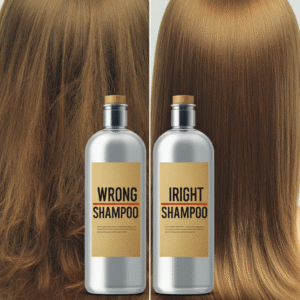
The Fix:
- Know Your Type: Identify your hair type (fine, coarse, straight, curly) and porosity level.
- Read the Labels: For low porosity hair, which is prone to product buildup, look for lightweight, clarifying formulas. For high porosity hair, which needs intense hydration, choose rich, moisturizing products with ingredients like shea butter or argan oil. Don’t be afraid to use a clarifying vs moisturizing shampoo as needed.
3. Applying Conditioner Incorrectly
Conditioner is meant to restore moisture and smooth the hair cuticle, but its placement matters. One of the most common hair mistakes is applying conditioner all over, including the roots. Your scalp produces its own oils, so adding a heavy conditioner there can lead to buildup, weigh down your hair, and make your roots greasy.
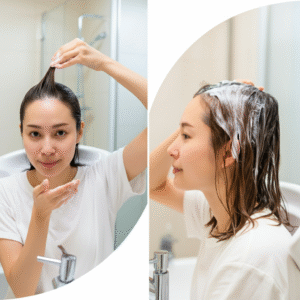
The Fix:
- Focus on the Ends: After shampooing, gently wring excess water from your hair. Apply conditioner from the mid-lengths to the ends, as this is the oldest and driest part of your hair.
- Distribute Evenly: Use your fingers or a wide-tooth comb to gently work the conditioner through your strands, ensuring every section is coated. This simple trick makes a huge difference in how to use conditioner effectively.
4. Ignoring Your Hair Porosity
You can buy the most expensive products, but if they aren’t right for your hair’s porosity, you’re wasting your money. Hair porosity determines how well your hair can absorb and hold onto moisture. Using the wrong products because you don’t know your porosity is a fundamental error in many routines.
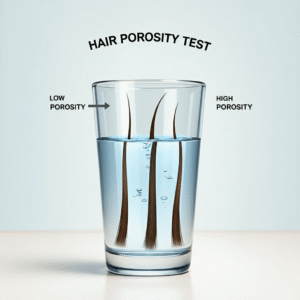
- Low Porosity: Cuticles are tightly packed. Hair is slow to get wet and slow to dry. It’s prone to product buildup because products sit on top of the hair instead of absorbing.
- High Porosity: Cuticles are raised or open. Hair absorbs water quickly but loses it just as fast, leading to frizz and dryness.
The Fix:
- Do a Porosity Test: A simple porosity test for hair can be done at home. Place a clean, dry strand of hair in a glass of water. If it floats, you have low porosity. If it sinks slowly, you have medium porosity. If it sinks quickly, you have high porosity.
- Adjust Your Routine: Low porosity hair benefits from lightweight products and occasional gentle heat (like a steamer or warm towel) to help products penetrate. High porosity hair needs richer creams, butters, and oils to seal in moisture. (Learn more with our guide: DIY Hair Tests: Type, Texture, and Porosity).
5. Brushing Wet Hair Aggressively
Hair is at its most fragile and elastic when wet. Pulling a brush through wet hair can stretch the strands to their breaking point, causing snapping, breakage, and split ends. This is a major factor in hair breakage prevention that many people overlook.
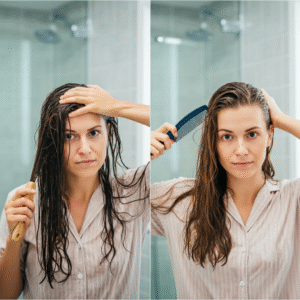
The Fix:
- Use the Right Tools: Swap your regular brush for a wide-tooth comb or a detangling brush specifically designed for wet hair.
- Start from the Ends: Begin detangling at the tips of your hair and gradually work your way up to the roots. This gentle method prevents you from pulling a knot tighter and causing breakage.
- Add Some Slip: Apply a leave-in conditioner or detangling spray to give your comb something to glide through, minimizing friction.
6. Skipping Heat Protection
If you use any form of heat on your hair—blow dryer, flat iron, curling wand—a heat protectant is non-negotiable. High temperatures degrade the protein structure (keratin) of your hair and boil the water within the strands, creating tiny, damaging bubbles. This heat styling damage leads directly to split ends, brittleness, and a loss of shine.
The Fix:
- Never Style Without It: Make applying a heat protectant spray a mandatory step. Mist it evenly over damp or dry hair before any heat tool touches your strands.
- Ensure Full Coverage: Section your hair to make sure every strand is coated. The pieces you miss are the ones that will suffer the most damage.
7. Using High Heat Tools Daily
Even with a heat protectant, daily exposure to high temperatures will take its toll. Constant heat styling strips hair of its natural moisture and elasticity, leaving it dull, lifeless, and prone to breakage. This is a fast track to severe heat damage that can be difficult to repair.
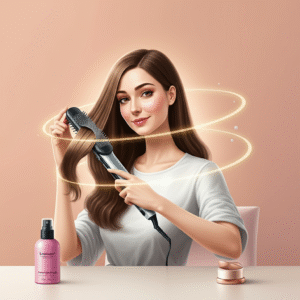
The Fix:
- Turn Down the Heat: You probably don’t need the highest setting on your tools. Start low and only increase the temperature if necessary to achieve your style. Fine hair requires much lower heat than coarse hair.
- Limit Use: Try to limit heat styling to 2-3 times per week. Embrace your natural texture or explore heat-free styling methods like braids, twists, or rollers on other days.
8. Tight Hairstyles and Constant Pulling
That sleek, tight ponytail or high bun might look chic, but it puts constant tension on your hair follicles. Over time, this pulling can lead to hair breakage and even a form of hair loss called traction alopecia, which often manifests as a thinning hairline.
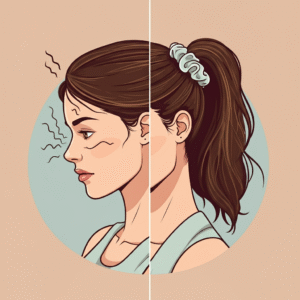
The Fix:
- Loosen Up: Opt for looser styles that don’t pull on your roots. Alternate your hairstyles daily to give your follicles a break.
- Use Gentle Accessories: Swap tight elastic bands for silk or satin scrunchies, spiral hair ties, or claw clips, which are much gentler on your hair.
9. Ignoring Your Scalp Health
Healthy hair starts with a healthy scalp. Product buildup, oil, and dead skin cells can clog hair follicles, impeding hair growth and causing scalp health issues like dandruff, itchiness, and inflammation. A clean and stimulated scalp is the foundation of any good hair care routine.

The Fix:
- Clarify Regularly: Use a clarifying shampoo once or twice a month to remove stubborn product buildup and refresh your scalp.
- Scalp Massage: When you shampoo, use your fingertips (not nails!) to gently massage your scalp. This boosts circulation, which helps deliver vital nutrients to your hair follicles.
- Exfoliate: Consider a scalp scrub or chemical exfoliant with ingredients like salicylic acid to keep follicles clear.
10. Overusing Hair Products
In the quest for perfect hair, it’s easy to get carried away and layer on serums, mousses, oils, and hairsprays. However, using too many products, especially heavy ones, leads to product buildup. This can weigh your hair down, make it look greasy, and block the cuticle from receiving moisture.

The Fix:
- Less is More: Start with a small, pea-sized amount of product and add more only if needed.
- Choose Lightweight Formulas: Look for water-based or lightweight hair products that won’t create a heavy film on your strands.
- Focus on Application: Apply products where they are needed most. For example, use volumizing mousse at the roots and smoothing serum on the ends.
11. Sleeping with Wet Hair
Going to bed with wet hair can feel like a time-saver, but it’s a recipe for hair damage. As you toss and turn, the friction between your damp, fragile hair and your cotton pillowcase can cause frizz, tangles, and breakage. The moist environment can also encourage fungal growth on the scalp.

The Fix:
- Dry Before Bed: Plan your hair washes to allow enough time for your hair to air-dry or blow-dry completely before sleep.
- Protective Surfaces: If you must sleep with damp hair, switch to a silk or satin pillowcase. These materials create less friction than cotton, reducing the risk of frizz and breakage. A silk or satin bonnet or scarf is another excellent option for protection.
12. Neglecting Regular Trims
If you’re trying to grow your hair long, cutting it might seem counterproductive. However, skipping trims is a major mistake. Split ends don’t heal; they travel up the hair shaft, causing the strand to fray further and eventually break off. Waiting too long for a trim often means you’ll have to cut off more length in the end to remove all the damage. Regular trims are essential for split ends causes and damage control.
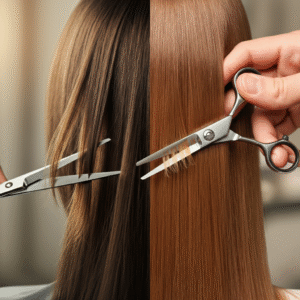
The Fix:
- Schedule Regular Cuts: Aim to get a trim every 8-12 weeks, even if it’s just a “dusting” to remove the very ends. This maintains the health and shape of your hair and prevents breakage from escalating.
13. Not Protecting Hair from the Sun
Just as UV rays damage your skin, they can also harm your hair. Sun exposure breaks down the hair cuticle, weakens protein bonds, and strips away pigment, leading to faded color, dryness, and brittleness. This is an often-overlooked form of hair damage.

The Fix:
- Cover Up: The easiest form of UV hair protection is a physical barrier. Wear a hat or a stylish scarf when you know you’ll be in the sun for an extended period.
- Use SPF for Hair: Look for leave-in conditioners, mists, or sprays that contain UV filters to shield your strands from sun damage.
14. Ignoring Your Specific Hair Type Needs
A one-size-fits-all approach to hair care rarely works. The routine that gives your friend with fine, straight hair amazing results will likely be a disaster for your thick, curly hair. Using products and techniques that aren’t suited to your hair’s unique texture and pattern is a setup for frustration.

The Fix:
- Customize Your Routine: Take the time to learn about your hair type. If you have curly hair, explore the “curly girl method.” If you have fine hair, focus on volumizing products and avoid heavy oils. Tailor every step of your routine, from washing to styling, to what your hair needs.
15. DIY Treatments Without Proper Knowledge
The internet is full of DIY hair mask recipes, but not all are created equal. While some natural ingredients are beneficial, others can be harmful. For example, applying acidic ingredients like straight lemon juice can disrupt your hair’s pH balance and cause extreme dryness, while ingredients like baking soda are far too alkaline and will strip your hair and irritate your scalp.
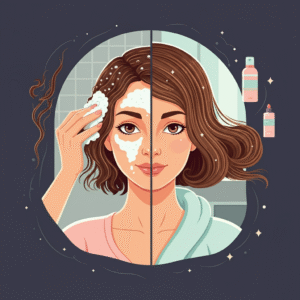
The Fix:
- Stick to Proven Ingredients: Use well-researched, safe home remedies. Ingredients like coconut oil, avocado, honey, and aloe Vera are generally safe and effective.
- Patch Test First: Before applying any new mixture to your entire head, test it on a small, inconspicuous section of hair to check for adverse reactions.
- When in Doubt, Buy: Professionally formulated hair masks are balanced for pH and contain ingredients at effective, safe concentrations.
Hair Care Mistakes by Hair Type
To make it even clearer, here’s a quick summary of common mistakes specific to different hair textures:
|
Hair Type |
Common Mistake |
The Solution |
|---|---|---|
|
Fine Hair |
Using heavy oils and creams that weigh it down. |
Opt for lightweight volumizing products and sprays. |
|
Coarse Hair |
Skipping deep conditioning, leading to dryness. |
Use moisture-rich masks and deep conditioners weekly. |
|
Curly Hair |
Brushing curls when dry, causing frizz and breakage. |
Detangle with fingers or a wide-tooth comb only when hair is wet and conditioned. |
|
Straight Hair |
Allowing too much product buildup, causing limpness. |
Incorporate a regular clarifying rinse into your routine. |
Hair Care Mistakes by Porosity Level
Tailoring your routine to your porosity is just as important:
|
Porosity |
Common Mistake |
The Fix |
|---|---|---|
|
Low Porosity |
Using heavy oils and butters that sit on the surface. |
Use gentle heat (steam, warm towel) to help lightweight products penetrate. |
|
High Porosity |
Skipping protein and failing to seal in moisture. |
Use protein treatments to fill gaps in the cuticle and seal with oils or butters. |
|
Medium Porosity |
Over-conditioning or overusing protein. |
Focus on maintaining a healthy moisture-protein balance without overdoing either. |
(Need more detailed guidance? Check out our Low Porosity Hair Care Guide).
How to Correct Existing Hair Damage
If you’ve recognized some of your own habits in this list, don’t despair. While you can’t magically repair a split end, you can restore the health of your hair and prevent future damage.
- Start with a Clean Slate: Use a clarifying shampoo to remove all product buildup.
- Get a Trim: Cut off the split, damaged ends to prevent them from traveling further up the hair shaft.
- Deep Condition: Introduce a weekly deep conditioning treatment to infuse your hair with moisture.
- Balance Protein: If your hair feels mushy or overly soft, it may need a protein treatment to restore its structure. Be careful not to overdo it, as too much protein can cause brittleness. Achieving the right moisture-protein balance is key.
- Protect and Be Gentle: Implement the fixes listed above. Eliminate heat, be gentle when detangling, and protect your hair from sun and friction.
- Be Patient: It takes time to see a difference. Stick with a healthy, consistent routine for 6-8 weeks to start seeing stronger, healthier new growth.
Bonus: Hair Care Myths Busted
Let’s clear up some common misinformation:
- Myth: Trimming your hair makes it grow faster.
Truth: Hair grows from the scalp, so cutting the ends has no effect on the rate of growth. However, regular trims prevent breakage, which helps you retain length and makes hair appear to grow faster. - Myth: Brushing your hair 100 strokes a day makes it shiny.
Truth: Over-brushing can cause friction, damage, and breakage. A few gentle strokes to detangle and distribute oils is all you need. - Myth: Rinsing with cold water seals the hair cuticle.
Truth: This is only partially true. A cold rinse can cause the cuticles to contract slightly, which may add a bit of shine, but it doesn’t “seal” them in a permanent way. A good conditioner is far more effective at smoothing the cuticle.
Conclusion
Beautiful, healthy hair is not just about genetics or expensive salon treatments; it’s the result of consistent, mindful habits. By identifying and correcting these common hair care mistakes, you can break the cycle of damage and put your hair on the path to recovery. Audit your current routine, be honest about your habits, and make small, incremental changes. Your hair will thank you by becoming stronger, shinier, and more resilient than ever before.

Frequently Asked Questions (FAQs)
Q: Can washing my hair every day cause hair loss?
A: Over-washing itself doesn’t directly cause hair loss from the follicle. However, it can lead to dryness and breakage, which results in the loss of hair length. The associated scalp inflammation from stripping oils can also create an unhealthy environment for hair growth.
Q: Is oiling necessary for everyone?
A: No. Hair oiling can be very beneficial for those with dry, coarse, or high porosity hair. However, for those with fine or low porosity hair, heavy oils can easily lead to greasy, weighed-down strands and product buildup.
Q: How can I tell if my hair is damaged?
A: Key signs of damaged hair include split ends, a rough or straw-like texture, excessive frizz, a lack of shine, and hair that tangles easily and breaks when you brush it. Another sign is hair that feels mushy or overly stretchy when wet.





Leave a Reply